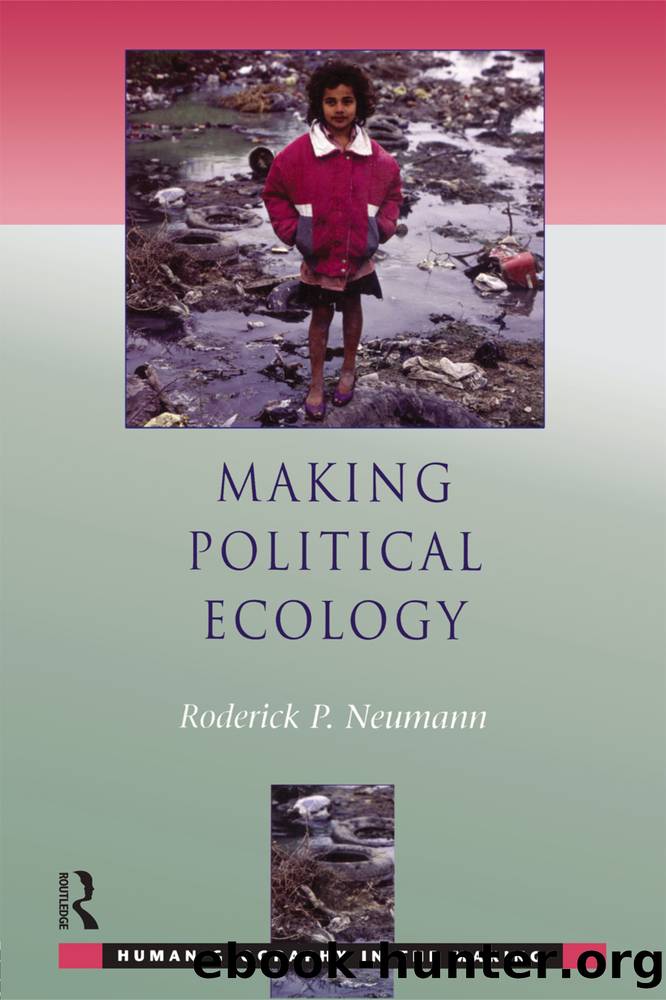Making Political Ecology by Neumann Rod;

Author:Neumann, Rod; [Neumann, Roderick P.]
Language: eng
Format: epub
Publisher: Taylor & Francis Group
Published: 2022-08-15T00:00:00+00:00
Extract 10
The consequences of the'desertification discourse'
A major finding of this comparative research on land-cover changes in the Katiali and Tagbanga areas is that, contrary to received wisdom, the savanna has become more wooded over the past thirty years.This finding runs counter to the dominant narrative, which assumes that the savanna has become less wooded and increasingly dominated by grass savannas. It also extends, both geographically and analytically, the findings of Fairhead and Leach on the expansion of wooded landscapes in the forest-savanna transition zone of Guinea (Fairhead and Leach 1996) to the sudanian savanna.
A second finding points to the diversity of savanna vegetation communities in the Korhogo region.The similarities and differences in the transformation of the Tagbanga and Katiali savanna areas underscore the importance of temporal and spatial variations in environmental change. This finding conforms to the scientific literature on savanna ecology that points to a wide range of plant communities, which are commonly distributed in mosaic form across the landscape. The most important factors influencing the nature and direction of vegetation change are farming systems, grazing pressure, population density, and changing fire regimes.These factors, which are themselves linked to changing political and economic processes extending beyond the region (e.g., cotton-development policies, immigration of Fulbe herders, or farmer-herder conflicts), interact with a host of biophysical factors such as soil type, slope, and rainfall to create temporally and locationally specific outcomes.
A third finding of this research is its relevance to environmental planning. Despite its problematic scientific status, the desertification narrative currently guides environmental policy. For example, NEAP-CI recommendations to combat the assumed reduction in tree cover include the regulation of bush fires through a range of increasingly coercive measures, restrictions on wood cutting, and the promotion of village-level tree planting. In light of the findings of this case study, such policy recommendations can be seen as misconceived and a waste of limited resources. The disjuncture between national and global environmental discourses and actual vegetation-change patterns is alarming. Our findings show that although desertification is not taking place, heavy grazing and early fires have significantly reduced the quality of the savanna for livestock raising. Tree and shrub invasion and a highly degraded herbaceous layer were evident in both the Katiali and Tagbanga study areas. Since livestock development is a priority of the Ministry of Agriculture, one would think that rangeland rehabilitation would be a centerpiece of the Cote dâIvoire NEAP.
Source: Bassett and Koli Bi (2000:89â90)
Download
This site does not store any files on its server. We only index and link to content provided by other sites. Please contact the content providers to delete copyright contents if any and email us, we'll remove relevant links or contents immediately.
Man-made Catastrophes and Risk Information Concealment by Dmitry Chernov & Didier Sornette(5921)
The Revenge of Geography: What the Map Tells Us About Coming Conflicts and the Battle Against Fate by Kaplan Robert D(4035)
Zero Waste Home by Bea Johnson(3781)
COSMOS by Carl Sagan(3554)
Good by S. Walden(3488)
In a Sunburned Country by Bill Bryson(3486)
The Fate of Rome: Climate, Disease, and the End of an Empire (The Princeton History of the Ancient World) by Kyle Harper(3003)
A Wilder Time by William E. Glassley(2818)
Camino Island by John Grisham(2763)
The Ogre by Doug Scott(2631)
Organic Mushroom Farming and Mycoremediation by Tradd Cotter(2628)
Human Dynamics Research in Smart and Connected Communities by Shih-Lung Shaw & Daniel Sui(2466)
Energy Myths and Realities by Vaclav Smil(2438)
The Traveler's Gift by Andy Andrews(2409)
9781803241661-PYTHON FOR ARCGIS PRO by Unknown(2323)
Inside the Middle East by Avi Melamed(2305)
Birds of New Guinea by Pratt Thane K.; Beehler Bruce M.; Anderton John C(2226)
A History of Warfare by John Keegan(2186)
Ultimate Navigation Manual by Lyle Brotherton(2130)
